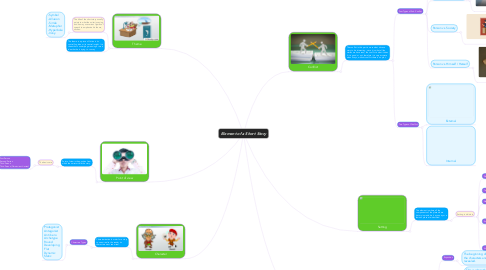
1. Point of view
1.1. Point of view is the position from which the narrator tells the story.
1.1.1. The basics are
1.1.1.1. -First Person -Second Person -Third Person -Third Person (Omniscient Limited)
1.1.1.1.1. Other
2. Theme
2.1. The title of the short story usually points to what the writer is saying and he may use various figures of speech to emphasize his theme, such as:
2.1.1. -Symbol -Allusion -Simile -Metaphor -Hyperbole -Irony.
2.2. The theme in a piece of fiction is its controlling idea or its central insight. It is the author's underlying meaning or main idea that he is trying to convey.
3. Character
3.1. Characterization In order for a story to seem real to the reader its characters must seem real.
3.1.1. Characters Types
3.1.1.1. Protagonist Antagonist Anti-hero Archetype Round Developing Flat Dynamic Static
4. Setting
4.1. This element is where all the components of the place where history is made, be it a country or a famous place are identified.
4.1.1. Setting is divide in
4.1.1.1. Place
4.1.1.1.1. - Where is the action of the story taking place? (Geographical Location)
4.1.1.2. Time
4.1.1.2.1. - When is the story taking place? (historical period, time of day, year)
4.1.1.3. Weather Conditions
4.1.1.3.1. - Is it rainy, sunny, stormy, etc.
4.1.1.4. Social Conditions
4.1.1.4.1. - What is the daily life of the character's like? -Does the story contain local color (writing that focuses on the speech, dress, mannerisms, customs, etc. of a particular place)
4.1.1.5. Atmosphere
4.1.1.5.1. -What feeling is created at the beginning of the story? -Is it bright and cheerful or dark and frightening?
5. Plot
5.1. The plot is basically the order that the writer makes when writing a story, in other words it is the order that the reading development takes.
5.1.1. It is divided into five parts
5.1.1.1. Exposition
5.1.1.1.1. The beginning of the story where the characters and the setting is revealed.
5.1.1.2. Rising Action
5.1.1.2.1. This is where the events in the story become complicated and the conflict in the story is revealed
5.1.1.3. Climax
5.1.1.3.1. This is the highest point of interest and the turning point of the story. The reader wonders what will happen next; will the conflict be resolved or not
5.1.1.4. Falling Action
5.1.1.4.1. The events and complications begin to resolve themselves.
5.1.1.5. Denouement
5.1.1.5.1. This is the final outcome or untangling of events in the story.
6. Conflict
6.1. The conflict in this part is more what drives a story to be interesting, since it is what all the stories we have read, the conflict is what it does if it is good or not, therefore it is very accurate when it says, without conflict there is no plot.
6.1.1. Four Types of Sub-Conflict
6.1.1.1. Person vs. Person
6.1.1.1.1. .
6.1.1.2. Person vs. Circumstances
6.1.1.2.1. .
6.1.1.3. Person vs. Society
6.1.1.3.1. .
6.1.1.4. Person vs. Himself / Herself
6.1.1.4.1. .
6.1.2. Two Types of Conflict
6.1.2.1. External
6.1.2.2. Internal
